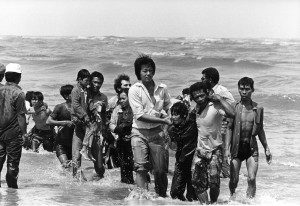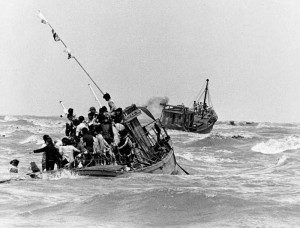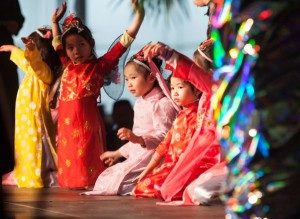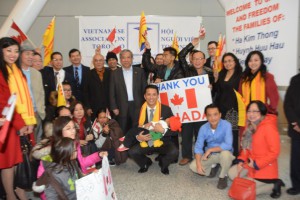Introduction
What followed the fall of Saigon on April 30, 1975, was the largest mass migration in modern history, with more than 2 million people leaving their war-torn country in search of freedom. The unique feature of the exodus of Vietnamese refugees was that, unlike most other forced migrations, where the displaced flee their country through mountains and deserts, their only immediate route for escape was by sea. This is why this group of refugees became known to the world as the “boat people.”
To see the legislative process of the Journey To Freedom day Act Click Here
The Boat People Exodus
Bolinao 52 Documentary:
Plot: Following the end of the Vietnam War in 1975, millions of refugees took the perilous escape across South China Sea to find freedom. Bolinao 52 is a long-silenced voice, an unspoken legacy of the Vietnam War – the story of the Vietnamese Boat People. [IMDB, 2015]
June 24, 1979 Vietnamese Boat People – The Price Of Freedom
Many Vietnamese refugees drew on their private resources to escape the advancing communist armies, prompting the Hanoi government to seal the country’s borders. After the Vietnam War, 65,000 South Vietnamese people were executed and 1 million were sent to prison and re-education camps, where an estimated 165,000 died because of retribution from the communist North.
In order to flee racial, ethnic, religious and political persecution, many refugees had to escape in rickety, broken boats for the South China Sea, where they faced constant, unimaginable peril. They faced not only deadly storms, but also disease and starvation. The primary causes of death for the boat people were drowning or attacks by pirates, who murdered them or sold them into slavery and prostitution. A story of Pirates and Sinking ships Dr. Tuan Tran recounts his harrowing escape from Vietnam to CBC news. According to the United Nation High Commission for Refugees, over 250,000 perished on the seas in search of freedom and a brighter future. The lucky ones were able to land alive at refugee camps. In this short 20 minute documentary: “Refuge for the unwanted” by the CBC visits camps in Hong Kong and Malaysia to document what life is like at refugee camps.
“I prayed hard for the horrible dream to end. I just wanted to wake up with all my children around me again… A new life lay ahead of us, and it was going to be a beautiful one”
– Pham Le Hong Nam

Resettlement In Canada
Some neighbouring countries turned the boat people away even when they did manage to land. This forced the refugees to travel farther and settle in the United States, the United Kingdom, France, Australia and Canada. Journey to Freedom Day is a recognition of Canada’s internationally acclaimed humanitarian role in welcoming over 120,000 refugees with open arms. The Journey to Freedom Day Act educates Canadians about the largest humanitarian effort in Canada up to that time, and it stands as the most massive influx of refugees we have ever seen. Following the growing migration of Vietnamese refugees, the federal government developed a private sponsorship program whereby it would seek assistance from voluntary organizations, churches and groups of at least five adult citizens who could sponsor and take a refugee family into their charge for one year. For each person sponsored, the government accepted another refugee under its own care. Without the warm and caring efforts of thousands of Canadians and under the leadership, support and co-operation of federal, provincial and municipal governments, as well as Canadian and international refugee agencies, non-governmental organizations and religious groups, the movement of such large numbers of people under such urgent and difficult circumstances would not have been possible.
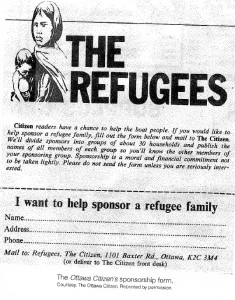


Welcome To Canada: Vietnamese Refugees Arrive
This nationwide effort was an unprecedented example of compassion shown by Canadians of all walks of life, many of them inviting families into their homes for a full year, where they helped their new guests settle in a new and unfamiliar land – helping them find a job or an education, and helping them find permanent homes.
Sally Caudwell of the CBC reports on the first flight of refugees arriving from Hong Kong at Pearson International Airport in Toronto and how they adapt to their new life in Canada.
History Of Boat People
Chronology Of Canada's Resettlement Efforts From 1975 to 1991
- April to May 1975: Promise of Visa letters are sent to 3,500 heads of family in Vietnam, encompassing approximately 14 to 15 thousand family members. On May 1, Canada decides to accept sponsored refugees by relatives already in Canada.
- April 1975: Vietnamese orphans arrive in Canada.
- April 24, 1975: Canadian Embassy officials in Saigon are evacuated.
- April 30, 1975: Saigon falls. Approximately 140, 000 people flee the country by boat and helicopter. Many are rescued by the U.S. Navy.
- May 1975: Canada announces it will accept escapees from Vietnam who have relatives in Canada. An additional 3,000 Vietnamese refugees with no family connections would also be permitted to settle in Canada.
- June 1975: Large groups of South Vietnamese are sent to re-education camps.
- May to June 1975: The “re-education” of defeated South Vietnamese military and government officials begins. People escape from Vietnam in small boats, marking the beginning of the “boat people” phenomenon.
- May 1975 to December 1976: A total of 7,000 refugees arrive in Canada, 4,500 of them arriving in the two months immediately following the fall of Saigon.
- August 1976: An additional 450 boat people are authorized for resettlement in Canada.
- January 1978: Under a “metered approach,” Canada begins to accept 50 families of boat people per month.
- 1979: The Canadian government makes its historic announcement setting a target of admitting 50,000 Vietnamese refugees to Canada by the end of 1980.
- June 1979: The annual target for Indochinese refugees is increased from 5,000 to 8,000. The government asks the voluntary sector to sponsor an additional 4,000 refugees under the new Private Refugee Sponsorship Program.
- July 20-21, 1979: External Affairs Minister Flora MacDonald announces that Canada will accept 50,000 refugees; 50% will be through private sponsorship.
- July 1979: Various initiatives are established—Ottawa’s Project 4000, Toronto’s Operation Lifeline, and the Vancouver Taskforce—providing a coordinating framework for facilitating individual and group sponsorships in Canada.
- July 1979: The government charters 76 flights to transport 15,800 refugees by the end of 1979. The monthly rate of arrival increases from 1,000 to 3,000.
- July 1979: The government instructs the Department of National Defense and Employment and Immigration Canada to establish staging areas (reception centres) at Canadian Forces bases Longue-Pointe (Montreal) and Greisbach (Edmonton) to receive incoming refugees arriving on charter flights.
- August 8, 1979: The first charter flight arrives in Montreal and is greeted at Longue-Pointe.
- August 29, 1979: By the end of August 10, 643 refugees are sponsored by 1,893 sponsorship groups in Canada.
- September 21, 1979: A total of 17,147 refugees are sponsored by 3,122 sponsorship groups in Canada.
- January 4, 1980: A total of 33,114 refugees are sponsored by 6,003 private sponsors in Canada.
- April 2, 1980: The Canadian government announces that 10,000 additional government-assisted refugees will be accepted by the end of 1980, bringing the total 1979-80 target for Indochinese refugees to 60,000.*
*Of the 60,000 Vietnamese refugees admitted to Canada between 1979 and 1980, roughly 26,000 were government-assisted, while some 34,000 were taken in by private sponsors and relatives.
- 1982 to 1991: An additional 79,695 refugees enter the country, bringing the total number of refugees accepted by Canada to 139,695.
The Nansen Medal Awarded To The People of Canada
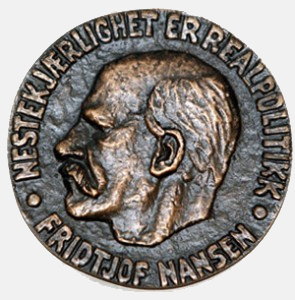
Canada successfully resettled refugees in all ten provinces and two territories. It is considered an exemplary moment in Canada’s history of humanitarian protection and, in fact, was a contributing factor to the United Nations High Commissioner for Refugees awarding its Nansen Refugee Award to the “People of Canada” in 1986. Canada’s compassionate response included many sectors, communities and all levels of governments. It was the first and only time that this prestigious medal was awarded to an entire nation.
The Vietnamese-Canadian Community
Journey to Freedom Day commemorates a key moment in Canada’s history by celebrating the country’s role in the Vietnamese refugees’ journey to freedom, which began 40 years ago. It also celebrates the significant contributions made by Vietnamese-Canadians since their arrival on Canadian shores.
Given the overwhelming success of the Private Sponsorship of Refugees Program in addressing the refugee exodus after the fall of Saigon, it became enshrined as a fundamental part of Canada’s Refugee Resettlement Program. Contributing to the success story of the Vietnamese refugees who settled in Canada are the Vietnamese people themselves. Vietnamese-Canadians actively participate in Canadian public life, distinguishing themselves in business, politics, the arts, sports and humanitarian endeavours.
Canada is now home to more than 300,000 Vietnamese-Canadians—three proud generations who celebrate an important heritage in a great nation and contribute to our society’s growth and prosperity. Since coming to Canada, the Vietnamese communities have consistently shown that they are hard-working Canadians capable of becoming an integral part of Canadian society. On April 30 of every year, the Vietnamese-Canadian community comes together to commemorate the boat people’s journey to Canada after the fall of Saigon and to remember the hundreds of thousands of refugees and boat people who lost their lives in an attempt to find a better future and in pursuit of freedom. To honour the perilous journey to freedom, April 30 is also remembered as a day to celebrate the values of democracy and human rights, the rule of law and a new beginning in Canada.
 One of the boat people include Dr Hải Thông Nguyễn. Nguyễn is now the chief of service of medicine at Ste-Anne’s Hospital, a long-term care facility for Canadian war veterans in Montreal. In 2012, Nguyễn was awarded the Queen Diamond Jubilee Medal for his distinguished service and his devotion in caring for elderly war veterans. Click to continue to learn more about Nguyễn story.
One of the boat people include Dr Hải Thông Nguyễn. Nguyễn is now the chief of service of medicine at Ste-Anne’s Hospital, a long-term care facility for Canadian war veterans in Montreal. In 2012, Nguyễn was awarded the Queen Diamond Jubilee Medal for his distinguished service and his devotion in caring for elderly war veterans. Click to continue to learn more about Nguyễn story.
“APRIL 30 IS A DAY WHEN WE THANK CANADA
FOR SAVING OUR LIVES…”
– Senator Ngo
Many of those who came to Canada as boat people and refugees today sponsor refugees themselves. They have again partnered with the Canadian government to bring to Canada the last remaining Vietnamese refugees who have been stranded without status in Thailand and the Philippines for nearly 40 years. This proud legacy is the Vietnamese-Canadian community’s way of marking their own Journey to Freedom – by helping others.
Asian Heritage Month
In May 2002, the Canadian government adopted Senator Vivienne Poy’s motion to designate the month of May as Asian Heritage Month. The month honours the contributions that Asian Canadians have made in society, and celebrates the diversity, history, and culture of people of Asian ancestry.

Canada is recognized as a multicultural country that embraces all races and ethnicities. Asian Heritage Month gives all Canadians an opportunity to acknowledge the legacy of Asian Canadians across Canada as well as their outstanding accomplishments in an eclectic of fields.
See more on Asian Heritage Month.
Articles on the newly arrived refugees: http://www.ctvnews.ca/canada/after-decades-stranded-in-thailand-28-vietnamese-refugees-arrive-in-canada-1.2104156




